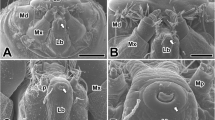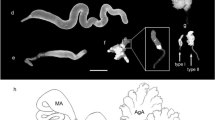Abstract
The mechanism of silk formation inApis mellifera salivary glands, during the 5th instar, was studied. Larval salivary glands were dissected and prepared for light and polarized light microscopy, as well as for scanning and transmission electron microscopy. The results showed that silk formation starts at the middle of the 5th instar and finishes at the end of the same instar. This process begins in the distal secretory portion of the gland, going towards the proximal secretory portion; and from the periphery to the center of the gland lumen. The silk proteins are released from the secretory cells as a homogeneous substance that polymerizes in the lumen to form compact birefringent tactoids. Secondly, the water absorption from the lumen secretion, carried out by secretory and duct cells, promotes aggregation of the tactoids that form a spiral-shape filament with a zigzag pattern. This pattern is also the results of the silk compression in the gland lumen and represents a high concentration of macromolecularly well-oriented silk proteins.
Similar content being viewed by others
Abbreviations
- MFFs:
-
Mass of fibroin fibers
- SEM:
-
scanning electron microscopy
- TEM:
-
transmission electron microscopy
References
Akai H, Imai T and Tsubouchi K 1987 Fine-structural changes of liquid silk in the silk gland during the spinning stage ofBombyx larvae;J. Seric. Sci. Jpn. 56 131–137
Akai H T 1983 The structure and ultrastructure of the silk gland;Experientia 39 443–449
Casem M L, Tran L P and Moore A M 2002 Ultrastructure of the major ampullate gland of the black widow spider,Latrodectus hesperus;Tissue Cell. 34 427–436
Chapman R F 1998The insects: Structure and Function. 4 (Cambridge: Cambridge University Press)
Craig C L, Hsu M, Kaplan D and Pierce N E 1999 A comparison of the composition of silk proteins produced by spiders and insects;Int. J. Biol. Macromol. 24 109–118
Engster M S 1976 Studies on silk secretion in the Trichoptera (F. Limnephilidae): II- Structure and amino acid composition of the silk;Cell Tissue Res. 169 77–92
Flower N E and Kenchington W 1967 Studies on insect fibrous proteins: the larval silk ofApis, Bombus andVespa;J. Roy. Micro. Soc. 86 297–310
Goitein M R 1989Estudos morfológicos e morfométricos do corpo gorduroso e enócitos de Apis mellifera (Hymenoptera, Apidae): aspectos histológicos e histoquímicos, Master Degree Thesis, Universidade Estadual Paulista, Rio Claro, Brasil
Jin H J and Kaplan D L 2003 Mechanism of silk processing in insects and spiders;Nature (London) 424 1057–1061
Mello M L S and Vidal B C 1980Práticas de Biologia Celular (ed.) E Blucher (São Paulo-Brasil: Funcamp)
Oschman J L and Berridge M J 1970 Structural and functional aspects of salivary fluid secretion inCalliphora;Tissue Cell. 2 281–310
Petralia R S, Sorensen A A and Vinson S B 1980 The labial gland system of larvae of the imported fire antSolenopsis invicta BUREN (Hymenoptera: Formicidae);Int. J. Insect Morphol. Embryol. 9 89–106
Rudall K M 1962 Silk and other cocoon protein; inComparative biochemistry (eds) M Florkin and H S Mason (New York: Academic Press) pp 397–433
Rudall K M and Kenchington W 1971 Arthropod Silks: the problem of fibrous proteins in animal tissues;Annu. Rev. Entomol. 16 73–96
Sehnal F and Akai H 1990 Insect silk glands: their development and function, and effects of environmental factors and morphogenetic hormones of them;Int. J. Insect Morphol. Embryol. 19 79–132
Silva de Moraes R L M and Cruz-Landim C 1975 Ultraestrutura da glândula salivar larval deApis mellifera adansonii (Hymenoptera, Apidae); inAnais do 3° Congresso Brasileiro de Apicultura (Piracicaba, SP, Brasil) pp 145–152
Silva E C M 1999Caracterização histoquímica das glândulas salivares larvais de Apis mellifera (Hymenoptera: Apidae) durante o desenvolvimento larval, Master Degree Thesis, Universidade Estadual Paulista, Rio Claro, Brasil
Silva E C M and Silva de Moraes R L M 1996 Histochemical aspects of the larval salivary glands ofApis mellifera (Hymenoptera, Apidae);Brazil. J. Morphol. Sci. 13 143
Silva E C M and Silva de Moraes R L M 2002 Cell and secretion functional differentiation ofApis mellifera silk glands;Naturalia 27 29–45
Zara J F 2002Estudo químico, bioquímico e citoquímico da região posterior da glândula salivar de larvas do último estágio de formigas Pachycondyla (= Neoponera) villosa (Hymenoptera: Formicidae), Doctor Degree Thesis, Universidade Estadual Paulista, Rio Claro, Brasil
Zara J F and Caetano F H 2002 Ultrastructure of the salivary glands ofPachycondyla (= Neoponera) villosa (Fabricius) (Formicidae: Ponerinae): functional changes during the last larval instar;Cytologia 67 267–280
Author information
Authors and Affiliations
Corresponding author
Rights and permissions
About this article
Cite this article
Silva-Zacarin, E.C.M., De Moraes, R.L.M.S. & Taboga, S.R. Silk formation mechanisms in the larval salivary glands ofApis mellifera (Hymenoptera: Apidae). J Biosci 28, 753–764 (2003). https://doi.org/10.1007/BF02708436
Received:
Accepted:
Issue Date:
DOI: https://doi.org/10.1007/BF02708436




